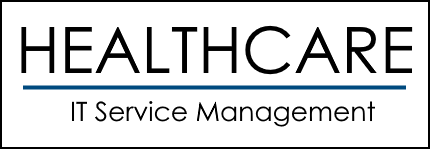Table of Contents
ToggleMany businesses, not just healthcare, are struggling with complicated and low performing IT departments. There are many issues that can cause this but often businesses make the mistake of hiring IT support staff thinking that it will be enough to ensure consistent results that promote business growth. IT is unknown to a lot of executives and it forces them to trust this IT person day 1 without the correct strategy in place for success. While simple IT support is great for resolving day-to-day break fix issues, over the long term more is needed, because other core IT roles are overlooked.
With the right ITSM strategy, you’ll have peace of mind knowing that all your technology systems and supports are performing well for patients and employees alike.
Mistake #1: Understanding what IT Service Management
Many healthcare businesses make the mistake of focusing on their short-term goals or current pains and aches at the expense of considering the big picture.
Listed below are the roles that must have professional efforts and resources dedicated in some fashion.
- IT Finance (Spending strategy on talent and technology)
- IT Project and Infrastructure (New Technologies)
- Helpdesk (Already in operation Technologies)
- Cybersecurity and Governance (Both are equally important)
- Information Systems (Operational Software)
Mistake #2: Thinking Short-Term
Your best chance of success comes when you understand your long-term goals for implementing ITSM.
This short-term approach typically focuses on the technology or a technology pain point, which is only one small aspect of your overarching ITSM roles. ITSM is designed to be a cost effective approach that ensures all needs are being met. Thinking long-term when it comes to ITSM implementation ensures that any problems or areas that require improvement are fully addressed. This should offer immediate results, but it will provide lasting results for the future.
Mistake #3: Leadership
Leadership and vision must be in all the roles to answer the challenges of today and the future. This also means business must plan for continuous service improvement and innovation to stay relevant. ITSM is not designed to be a quick fix or a set-it-and-forget-it solution that can be left to operate on its own. Someone needs to be proactive when it comes to ITSM strategy and execution. Technology is ever-evolving, and you must make sure your business is equipped to change along with it. An example is ensuring your IT finance strategy and efforts are balanced throughout all the ITSM so that nothing falls short.
Mistake #4: Hyper-Focusing on Technology
Why does a nice sales guy and a game of golf always end in some expensive overpriced technology that our business desperately needs all of the sudden?
Focusing too much on technology can cause your ITSM strategy to fail. ITSM involves more than technology; it involves your business’ practices and goals as well as the goals and desires of your customers or users.
Choosing the right technology is important, you also need to make sure you are guarding against technology glamor and forgetting about your main offerings as a business.
Any easy rule of thumb to keep when buying technology?
- With this technology will our business drastically improve the work we do?
- What do our colleagues and competitors use in the market and how do we stack up?
- Does the technology being proposed contain a fully unbiased layout beginning to end?
Mistake #5: Lack of Talent
Businesses are struggling with tight budgets and resource allocation issues. There are not easy buttons to technology. IT techs need training to be able to handle today’s issues (This can be little or no cost to your company) Your business needs motivated staff and technical skill in tandem with ITSM strategy.
Below lists these ideas in relation to the roles that are required.
- IT Finance – Does your IT Department work with the CFO and understand the Budget Impacts and procurement strategy. Is there labor and work metrics supporting an operation plan?
- IT Project and Infrastructure – Do projects have project management skills?
- Helpdesk (Break Fix) – Does your helpdesk have diagnostic ability paired with customer service?
- Cybersecurity and Governance – Governance sets the Authority and IT uploads the requirements there are multiple frameworks for this.
- Information Systems (Business Software) – Do you have software Subject matter experts that are non-IT?
Mistake #6: Poor Communication
Business leaders don’t make time and connect with the IT department. IT can bring your company to a halt with one wrong move or can shift and grow your company overnight with simple technology advantages. The point IT matters and the teams are not just nerds at the end of the table.
As with any change you make to your business, it is important to communicate the relevant business vision and sync it with your ITSM implementation.. You must ensure that users are aware of the new features and functions that are designed to benefit them or the reduction in technology spent to use budget dollars in other areas.
You must also ensure you are taking the time to properly train your staff and anyone else who will be implementing new technology or procedures. ITSM is designed to improve workflow and productivity. This can only be achieved if everyone understands what has changed and how to utilize the new processes.
Avoid ITSM Failures
When implemented successfully, Healthcare ITSM services provide numerous benefits for your healthcare business. The process starts with understanding what ITSM is and what it can do for your business. From there, you can determine which tools, procedures, and processes will work best for the unique services you provide. You’ll want to keep your long-term goals in mind, while understanding that success in ITSM involves the ability and willingness to adapt to change.
If you are unsure, the professionals at Healthcare IT Management Services can help.

With over 16 years in the industry, Jameson Lee has honed his skills in IT management, project execution, and strategic planning. His ability to align technology initiatives with business goals has consistently delivered remarkable results for organizations across various sectors.
Jameson’s educational background includes an Associate of Applied Science degree in Computer Networking Systems, providing him with a solid foundation in technical concepts and best practices. Complementing his technical acumen, he has also completed coursework in Business Administration, equipping him with a well-rounded understanding of the operational aspects of running successful businesses.
Driven by a commitment to staying ahead of industry trends, Jameson actively pursues professional certifications and continuous learning opportunities. His credentials include CompTIA A+, N+, and Security+, along with MCP and MCTS certifications. This dedication ensures that he remains at the forefront of technological advancements, enabling him to offer innovative solutions to complex challenges.
What sets Jameson apart is his personable approach to working with clients. He believes in fostering strong relationships and effective communication, collaborating closely with stakeholders to understand their unique needs, and provide tailored technology solutions. By building trust and understanding, Jameson ensures that every project is aligned with the client’s vision and objectives.
Throughout his career, Jameson has successfully led teams and implemented robust frameworks to optimize performance and achieve remarkable technological initiatives. Whether it’s streamlining operations, enhancing cybersecurity measures, or implementing cutting-edge software solutions, Jameson has consistently delivered tangible outcomes for his clients.
As a trusted IT partner, Jameson’s mission is to empower businesses with technology solutions that drive growth, efficiency, and competitive advantage. With his expertise, dedication, and personable approach, Jameson Lee is the catalyst for transforming your business through the power of technology.



